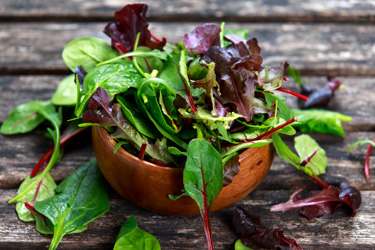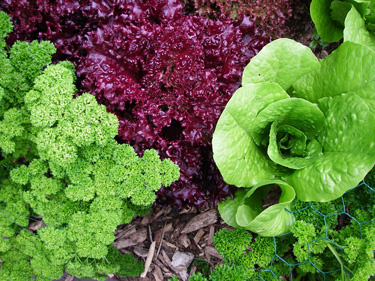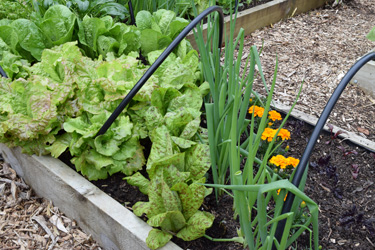The great garden salad
Spring into healthy eating
When we grow them at home, our salads are as organic and as fresh as we choose. Fresher than a shop bought ‘garden salad’ can ever be.
Gluten-fee, fat-free, sugar-free, dairy-free, no additives, no preservatives, not to mention vegan. What other food group can fulfil so many dietary requirements? Home-grown is as local and sustainable as it gets; there are no food miles involved except perhaps for that enjoyable outing to the garden centre.
Add convenience and low cost to the wish list there’s no escaping the obvious - a constant home grown supply is something worth striving for. Luckily, salad greens are super quick and easy to grow and a surprising amount can be grown in a small space. You can grow your greens in containers. You can even grow your greens indoors.
There is an exciting assortment of lettuce varieties on offer. But a great salad has more than just lettuce. There is a host of other edible leaves that are easy to grow and well worth it for nutritious salads that are never boring. Dark green beets, pungent Asian greens, cress, rocket, sorrel and other herbs bring different nutrients to the mix while providing extra pep to your daily salad. Having a variety ready for picking at any time of year means you can create something interesting for every meal.
Gourmet greens to grow
TASTY: Rocket, chives, basil, mint, pea shoots, coriander, celery leaves, pak choi, micro greens.
TANGY: Chicory, cress, rocket, beet leaves, spinach, sorrel, radicchio, nasturtium leaves, mustard leaves.
EXTRA TEXTURE: Mizuna, endive, Green Oak lettuce, Frisby lettuce, Italian parsley, pea shoots, snow peas, miner's lettuce.
CRUNCHY: Micro-greens, Cos lettuce, Great Lakes lettuce, Triumph lettuce, Iceberg lettuce.
COLOURFUL: Baby beetroot leaves, red chicory, lettuces: Red Oak, Drunken Woman, Merveille des Quatre Saisons, Buttercrunch, Tom Thumb, Lollo Rosso, Red Sails. Edible flowers: chives, nasturtium, calendula, viola, borage.
Early spring planting
Temperature
Most lettuces are quite cold hardy but as tender young seedlings they’re vulnerable to frost. When planting outdoors, wait till the frosty weather has passed before planting, or keep seedlings covered with a cloche. Choose a sheltered spot, away from chilling winds.
In spring a sunny spot is best (in the hottest part of summer, lettuces like some shade). Cold soggy soil is the main obstacle to growth in early spring, but this can be overcome by planting early spring crops in raised beds or containers. Try a cloche for extra warmth and protection.
Seeds or seedlings?
Most vege gardeners grow both. Buying ready-to-plant seedlings from the garden centre is a great way to get started, especially for those wanting to grow a range of varieties in a small space. Water gently after planting and don’t forget the slug bait.
Growing from seed opens up an even wider choice of varieties to try and is ideal if you want to grow lots. The temptation may be to sow an entire packet at one time but for a constant supply it is far better to sow in batches every couple of weeks. September is an ideal time to sow seed. Seeds sown directly into cool soil will be slow to germinate but we can speed things up by starting in trays of seed raising mix to plant out later. If growing salad greens in containers, seed can be sown directly into the container mix.
Watering
The biggest mistake those who are new to seed sowing make is letting the seed bed dry out. Keep your seed trays somewhere in view so you won’t forget about them. Fill a spray bottle with water and keep it handy. Check daily and keep your seed bed moist. A blast with a hose or flooding with a watering can risks washing you seeds away. Avoid cold wet soil overnight by watering in the early morning rather than the afternoon or evening.
Soil nutrition
Digging plenty of compost into your vege plot prior to planting will provide extra warmth for seedlings and improve your soils ability to retain nutrients. Regularly replenishing with compost is the most cost effective way to keep your soil healthy, especially if you make your own. To further improve soil structure (especially on heavy clay soils) an application of gypsum is a good idea. Gypsum supports healthy water movement in the soil. It also contains calcium and sulphate (sulphur or sulphates?)for improved plant health and disease resistance.
Leafy vegetables need plenty of nitrogen but it’s important to provide a balanced diet of nutrients for healthy root growth and disease resistance. Sheep pellets, blood and bone or other well-composted animal manure can be mixed into the soil before planting. Fast acting supplementary fertilisers, including liquid plant foods can be applied once plants are in active growth.
Feeding little and often is best to keep up with plant growth while avoiding waste and environmental harm. Controlled release fertilisers offer a convenient way of achieving this. Veges in containers grow best with controlled-release fertiliser (good potting mix comes with this already added) supplemented by regular liquid feeding.
Microgreens
If you’ve sown too many seeds, you can always eat them as ‘micro-greens’. Microgreens are simply herbs and vegetables eaten at the tiny seedling stage, two leaves further on from a sprout, just a week or two after germination. They look cute on the plate and contain a high concentration of nutrients. Almost any vege plant can be eaten as a microgreen, including fennel, rocket, green and purple basil, spinach, celery, cress, mizuna, silverbeet, beetroot and radish leaves, carrot, mustard, cress, beans, coriander, and nasturtium.
These tender treats are easily grown at home, in seed raising trays, even indoors if you have a sunny space. You might sow a whole tray of one variety or a mixture. Microgreen seeds come in packets ready-mixed or you can blend your own. Sow fresh seed every week for a constant supply.

1-Sep-2019


Mixed lettuce and parsley

Mixed lettuce and spring onions

Rocket microgreens

